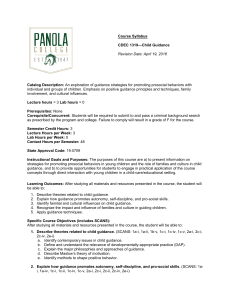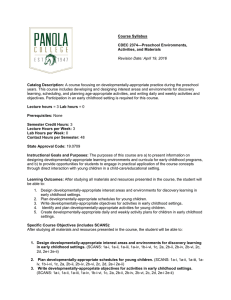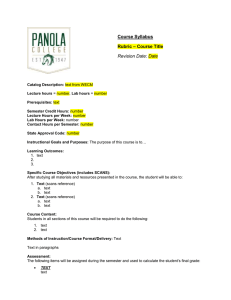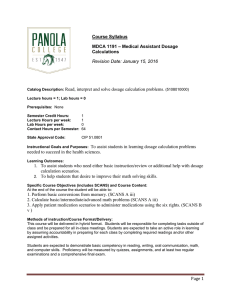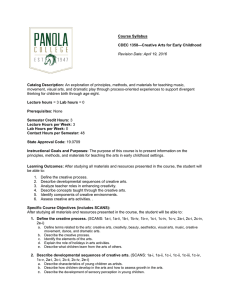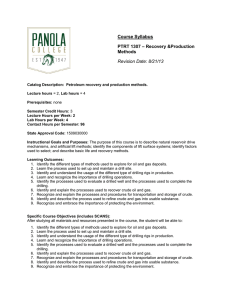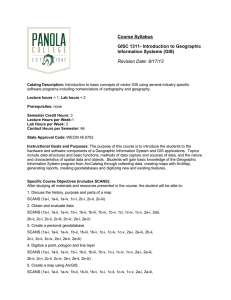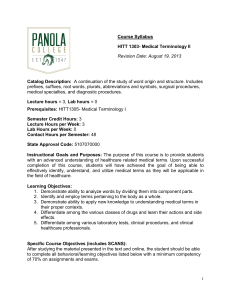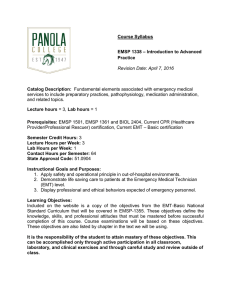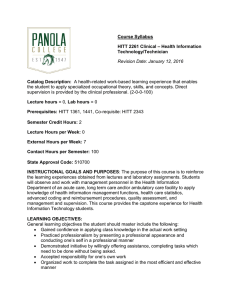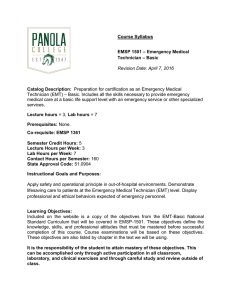Course Syllabus —Administrations of Programs for CDEC 2326 Children I
advertisement
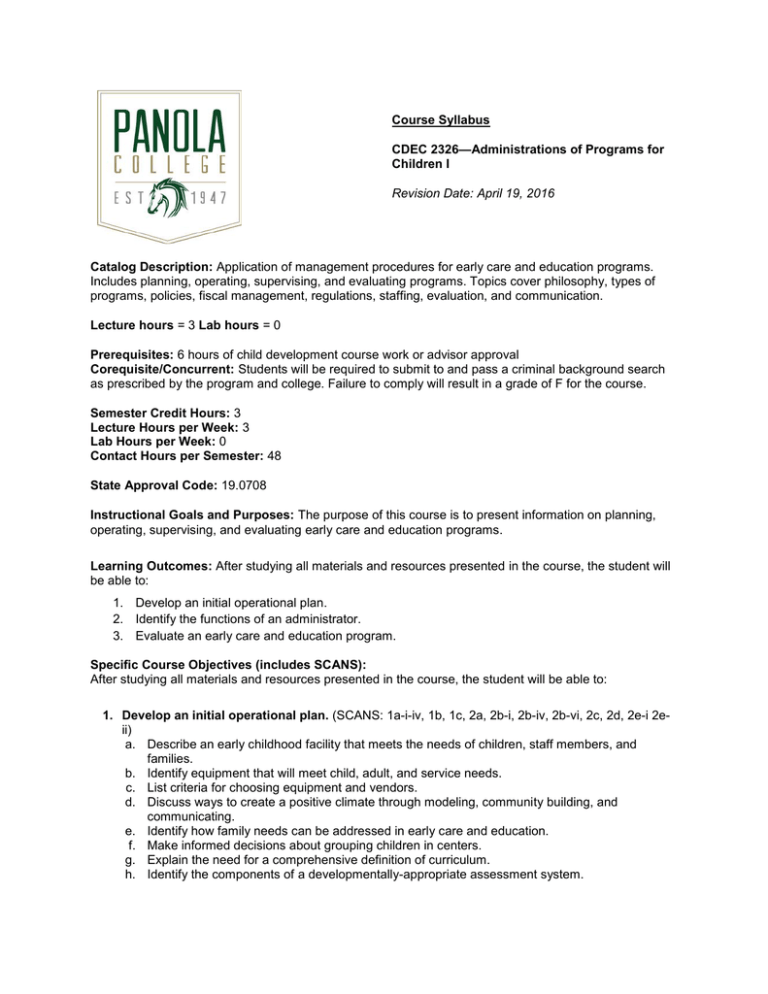
Course Syllabus CDEC 2326—Administrations of Programs for Children I Revision Date: April 19, 2016 Catalog Description: Application of management procedures for early care and education programs. Includes planning, operating, supervising, and evaluating programs. Topics cover philosophy, types of programs, policies, fiscal management, regulations, staffing, evaluation, and communication. Lecture hours = 3 Lab hours = 0 Prerequisites: 6 hours of child development course work or advisor approval Corequisite/Concurrent: Students will be required to submit to and pass a criminal background search as prescribed by the program and college. Failure to comply will result in a grade of F for the course. Semester Credit Hours: 3 Lecture Hours per Week: 3 Lab Hours per Week: 0 Contact Hours per Semester: 48 State Approval Code: 19.0708 Instructional Goals and Purposes: The purpose of this course is to present information on planning, operating, supervising, and evaluating early care and education programs. Learning Outcomes: After studying all materials and resources presented in the course, the student will be able to: 1. Develop an initial operational plan. 2. Identify the functions of an administrator. 3. Evaluate an early care and education program. Specific Course Objectives (includes SCANS): After studying all materials and resources presented in the course, the student will be able to: 1. Develop an initial operational plan. (SCANS: 1a-i-iv, 1b, 1c, 2a, 2b-i, 2b-iv, 2b-vi, 2c, 2d, 2e-i 2eii) a. Describe an early childhood facility that meets the needs of children, staff members, and families. b. Identify equipment that will meet child, adult, and service needs. c. List criteria for choosing equipment and vendors. d. Discuss ways to create a positive climate through modeling, community building, and communicating. e. Identify how family needs can be addressed in early care and education. f. Make informed decisions about grouping children in centers. g. Explain the need for a comprehensive definition of curriculum. h. Identify the components of a developmentally-appropriate assessment system. 2. Identify the functions of an administrator. (SCANS: 1a-i-iv, 1b, 1c, 2a, 2b-i, 2b-iv, 2b-vi, 2c, 2d, 2e-i 2e-ii) a. Explain the purpose of licensing. b. Identify the steps in the licensing process. c. Describe licensing regulations and their specific purposes. d. Explain general policies and procedures related to documenting fiscal transactions. e. Describe how and why a budget is created. f. List financial documents other than a budget and explain why they are needed. g. Describe the director’s role in obtaining funding for a center. h. List resources available for child care funding. i. Explain the director’s role related to facilities management. j. Describe a system for ordering and managing equipment. k. Use mandates from federal laws to design policies and practices that support children with disabilities in early care and education settings. l. List steps in the intake process. m. Identify the connection between a strategic plan and a marketing plan. n. Identify the components of a well-developed marketing tool kit. o. Design effective marketing materials for a variety of marketing tools. p. Identify administrative styles and roles. q. Identify various levels of individual credentials available for staff in a child care and education center. r. Explain the relationship between director credentialing and career pathways. s. Write a job description for each position in a child-care center. t. Describe the interview and hiring process. u. Develop an orientation process for new employees. v. Describe the role of the director as educational leader and curriculum mentor. w. Apply the principles of developmentally-appropriate curriculum when mentoring teachers. x. Describe the process of scheduling and planning for staff meetings and professional development. y. Discuss the elements of an effective staff development system. z. Identify characteristics of teachers at all levels of the career lattice and plan professional development to meet their needs. aa. List the four principles of supervision. bb. Discuss ways to create a positive climate through modeling, community building, and communicating. cc. Identify strategies for establishing reciprocal relationships with families. dd. Discuss contents and the value of center newsletters. ee. Understand the process of recruiting and adding volunteers and becoming active in the community in which services are provided 3. Evaluate an early care and education program. (SCANS: 1a-i-iv, 1b, 1c, 2a, 2b-i, 2b-iv, 2b-vi, 2c, 2d, 2e-i 2e-ii) a. List the factors that influence the need for child care. b. Name types of child care used by families and describe their characteristics. c. Describe an early childhood facility that meets the needs of children, staff members, and families. d. Identify equipment that will meet child, adult, and service needs. e. List criteria for choosing equipment and vendors. f. Discuss ways to create a positive climate through modeling, community building, and communicating. g. Identify how family needs can be addressed in early care and education. h. Make informed decisions about grouping children in centers. i. Explain the need for a comprehensive definition of curriculum. j. Identify the components of a developmentally-appropriate assessment system. 2 Course Content: Students in all sections of this course will be required to do the following: 1. 2. 3. 4. 5. 6. Read assigned sections in the text. Use Canvas to access assignments and course materials. Locate information in the library databases or on the Internet when assigned. Use Canvas email to communicate with the instructor. Interact with other students and the instructor via assigned tools. Complete these assignments and exams showing progress toward mastery of objectives listed in the Syllabus: a. Projects b. Discussions c. Chapter Quizzes d. Exams (including comprehensive Final Exam) Methods of Instruction/Course Format/Delivery: Students in all sections of this class will have access to this course via the Canvas Learning Management System. Students in the face-to-face course will meet regularly to discuss the material. Online students will be required to meet with the instructor or testing proctor for testing only. Instruction and class participation will include: Instructor lecture or online facilitation Online submission of assignments Email Videos Discussion Board Practice Exams Quizzes Assessment: The grade for this course will be based on the following items assigned during the semester: Assignments: = 50% o Projects o Discussions o Chapter Quizzes Exams, including a comprehensive Final Exam = 50% Course Grade: The grade for this course will be based on the Grading Scale listed below. To earn a passing grade, all required documents for the four-hour field study component MUST be submitted ON or BEFORE the DUE DATE. Students who do not complete all four hours will not receive credit for the course, regardless of performance on other assignments. 90-100 % 80-89% 70-79% 60-69% Below 60% A B C D F Exams = 50% Assignments = 50% Texts, Materials, and Supplies: 3 TEXTBOOK(S): Developing and Administering a Child Care and Education Program, by Dorothy June Sciarra. (2013). Belmont, CA: Wadsworth. ISBN: 9781111833381 SOFTWARE: Web browser such as Google Chrome, Mozilla Firefox, or Internet Explorer—updated as necessary; access to MS WORD. Other: For current texts and materials, use the following link to access bookstore listings: http://www.panolacollegestore.com For testing services, use the following link: http://www.panola.edu/elearning/testing.html If any student in this class has special classroom or testing needs because of a physical learning or emotional condition, please contact the ADA Student Coordinator in Support Services located in the Administration Building or go to http://www.panola.edu/student-success/disability-supportservices/ for more information. Withdrawing from a course is the student’s responsibility. Students who do not attend class and who do not withdraw will receive the grade earned for the course. Student Handbook, The Pathfinder: http://www.panola.edu/studentsuccess/documents/pathfinder.pdf SCANS CRITERIA: (Letters and numbers in parentheses reference this list.) 1) 2) Foundation skills are defined in three areas: basic skills, thinking skills, and personal qualities. a) Basic Skills: A worker must read, write, perform arithmetic and mathematical operations, listen, and speak effectively. These skills include: i) Reading: locate, understand, and interpret written information in prose and in documents such as manuals, graphs, and schedules. ii) Writing: communicate thoughts, ideas, information, and messages in writing, and create documents such as letters, directions, manuals, reports, graphs, and flow charts. iii) Arithmetic and Mathematical Operations: perform basic computations and approach practical problems by choosing appropriately from a variety of mathematical techniques. iv) Listening: receive, attend to, interpret, and respond to verbal messages and other cues. v) Speaking: Organize ideas and communicate orally. b) Thinking Skills: A worker must think creatively, make decisions, solve problems, visualize, know how to learn, and reason effectively. These skills include: i) Creative Thinking: generate new ideas. ii) Decision Making: specify goals and constraints, generate alternatives, consider risks, and evaluate and choose the best alternative. iii) Problem Solving: recognize problems and devise and implement plan of action. iv) Visualize ("Seeing Things in the Mind's Eye"): organize and process symbols, pictures, graphs, objects, and other information. v) Knowing How to Learn: use efficient learning techniques to acquire and apply new knowledge and skills. vi) Reasoning: discover a rule or principle underlying the relationship between two or more objects and apply it when solving a problem. c) Personal Qualities: A worker must display responsibility, self-esteem, sociability, self-management, integrity, and honesty. i) Responsibility: exert a high level of effort and persevere toward goal attainment. ii) Self-Esteem: believe in one's own self-worth and maintain a positive view of oneself. iii) Sociability: demonstrate understanding, friendliness, adaptability, empathy, and politeness in group settings. iv) Self-Management: assess oneself accurately, set personal goals, monitor progress, and exhibit self-control. v) Integrity and Honesty: choose ethical courses of action. Workplace competencies are defined in five areas: resources, interpersonal skills, information, systems, and technology. a) Resources: A worker must identify, organize, plan, and allocate resources effectively. i) Time: select goal-relevant activities, rank them, allocate time, and prepare and follow schedules. ii) Money: Use or prepare budgets, make forecasts, keep records, and make adjustments to meet objectives. iii) Material and Facilities: Acquire, store, allocate, and use materials or space efficiently. Examples: construct a decision time line chart; use computer software to plan a project; prepare a budget; conduct a cost/benefits analysis; design an RFP process; write a job description; develop a staffing plan. 4 b) Interpersonal Skills: A worker must work with others effectively. i) Participate as a Member of a Team: contribute to group effort. ii) Teach Others New Skills. iii) Serve Clients/Customers: work to satisfy customer's expectations. iv) Exercise Leadership: communicate ideas to justify position, persuade and convince others, responsibly challenge existing procedures and policies. v) Negotiate: work toward agreements involving exchange of resources, resolve divergent interests. vi) Work with Diversity: work well with men and women from diverse backgrounds. Examples: collaborate with a group member to solve a problem; work through a group conflict situation, train a colleague; deal with a dissatisfied customer in person; select and use appropriate leadership styles; use effective delegation techniques; conduct an individual or team negotiation; demonstrate an understanding of how people from different cultural backgrounds might behave in various situations. c) Information: A worker must be able to acquire and use information. i) Acquire and Evaluate Information. ii) Organize and Maintain Information. iii) Interpret and Communicate Information. iv) Use Computers to Process Information. Examples: research and collect data from various sources; develop a form to collect data; develop an inventory recordkeeping system; produce a report using graphics; make an oral presentation using various media; use on-line computer data bases to research a report; use a computer spreadsheet to develop a budget. d) Systems: A worker must understand complex interrelationships. i) Understand Systems: know how social, organizational, and technological systems work and operate effectively with them. ii) Monitor and Correct Performance: distinguish trends, predict impacts on system operations, diagnose deviations in systems' performance and correct malfunctions. iii) Improve or Design Systems: suggest modifications to existing systems and develop new or alternative systems to improve performance. Examples: draw and interpret an organizational chart; develop a monitoring process; choose a situation needing improvement, break it down, examine it, propose an improvement, and implement it. e) Technology: A worker must be able to work with a variety of technologies. i) Select Technology: choose procedures, tools or equipment including computers and related technologies. ii) Apply Technologies to Task: understand overall intent and proper procedures for setup and operation of equipment. iii) Maintain and Troubleshoot Equipment: Prevent, identify, or solve problems with equipment, including computers and other technologies. Examples: read equipment descriptions and technical specifications to select equipment to meet needs; set up and assemble appropriate equipment from instructions; read and follow directions for troubleshooting and repairing equipment. 5
